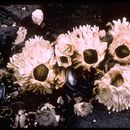Comprehensive Description
provided by Invertebrates of the Salish Sea
This sessile barnacle has 6 wall plates. The rostrum overlaps the wall plates on both sides of it. The tips of the terga form a slight beak when closed. The wall plates are composed of vertical tubelike ribs which, especially in the lower half, become downward-pointing fingerlike or thatchlike projections. The base is not heavily calcified so that, when the barnacle is broken off the rock, the base and some soft tissue remain attached to the rock. Wall plates white, brownish, gray, or greenish white. The cirri are almost black. Up to 6 cm diameter.
- license
- cc-by-nc-sa
- copyright
- Rosario Beach Marine Laboratory
Look Alikes
provided by Invertebrates of the Salish Sea
How to Distinguish from Similar Species: This is the only species locally that has the strong thatchlike external appearance. A bit farther south, Tetraclita rubescens has a similar appearance but it is a pinkish red color and has only 4 plates.
- license
- cc-by-nc-sa
- copyright
- Rosario Beach Marine Laboratory
Habitat
provided by Invertebrates of the Salish Sea
Attached to rocks, floats, or pilings. Not often found around fresh water. Especially common on steep shores with much current and waves in our area but on the open coast it is found in cracks and protected locations.
- license
- cc-by-nc-sa
- copyright
- Rosario Beach Marine Laboratory
Distribution
provided by Invertebrates of the Salish Sea
Geographical Range: Bering Sea to Morro Bay, Central California; Japan
- license
- cc-by-nc-sa
- copyright
- Rosario Beach Marine Laboratory
Comprehensive Description
provided by Invertebrates of the Salish Sea
Biology/Natural History: Farther south this species grows individually, but here in the Pacific Northwest aggregations can sometimes be so dense that the thatched appearance is not immediately evident. The barnacles grow very tall and narrow when densely aggregated. Competitors for space include Halichondria panicea, Mytilus trossulus, and Mytilus californianus. When the barnacles are small they may be bulldozed off the rocks by grazing limpets such as Lottia digitalis. The large size of adults likely protect them from some predators such as Nucella lamellosa or the seastars Pisaster ochraceous and Pycnopodia helianthoides. Eggs are brooded in the winter and the cyprid larvae settle in the spring. The larvae preferentially settle near adult barnacle shells. Lifespan up to 15 years. These barnacles appear to have been eaten by native tribes in SE Alaska in some coastal locations during an extended time period. At other times, mussels were a more common food in the same regions.
- license
- cc-by-nc-sa
- copyright
- Rosario Beach Marine Laboratory
Habitat
provided by Invertebrates of the Salish Sea
Depth Range: Mid intertidal to shallow subtidal. Especially common in the low intertidal, below the densest band of Balanus glandula and near Mytilus trossulus or M. californianus.
- license
- cc-by-nc-sa
- copyright
- Rosario Beach Marine Laboratory
Semibalanus cariosus
provided by wikipedia EN
Semibalanus cariosus, commonly known as the thatched barnacle, rock barnacle or horse barnacle,[2] is a species of acorn barnacle occurring in the northern Pacific Ocean.
Description
This barnacle has six wall plates which are sculpted with vertical tube-like ribs which extend downwards onto the rock in projections rather like the edge of a thatched roof. The rostrum overlaps the wall plates and the terga form a beak when the barnacle is closed. There is a sinuous line at the junction between the tergum and the scutum. This is a large species of barnacle and can grow to a diameter of 6 cm (2.4 in), but when densely packed together, individuals may be much taller than they are wide. The wall plates are white, greenish, brownish or gray. The base of the barnacle is little calcified so that when it is broken from the rock, a membrane and some soft tissues may be left behind.[2]
Distribution and habitat
Semibalanus cariosus is native to the northern Pacific Ocean including Japan and the Pacific Northwest coast of North America, where its range extends from the Bering Sea to Morro Bay, California. It is found on rocks, pilings and other man-made structures from the mid-intertidal zone down to the shallow subtidal zone. In general, it occupies a belt below the zone occupied by Balanus glandula, often near beds of the California mussel (Mytilus californianus) and the bay mussel (Mytilus trossulus); it may be very numerous and is often the commonest organism in this belt.[2]
Ecology
Like other acorn barnacles, S. cariosus is a filter feeder; when it is under water, the moveable terga at the apex part, and the cirri are extended to feed. When above water, the terga shut tightly for protection and to prevent desiccation. Small barnacles are sometimes "bulldozed" off the rock by the limpet Lottia digitalis while it is grazing.[2] Predatory gastropod mollusks, such as the channeled dog winkle (Nucella canaliculata), drill into the barnacle shell and then inject a toxin which causes the muscles to relax, enabling the winkle to consume the soft parts. The winkles were more successful at gaining entry if they drilled between the wall plates of the barnacle rather than through them.[3] Larger barnacles may be too big for the frilled dogwinkle (Nucella lamellosa), the purple seastar (Pisaster ochraceus) or the sunflower sea star (Pycnopodia helianthoides) to tackle.[2]
Human use
Native Americans such as the Quinault people of Washington State used barnacles as a food resource, the staples of the diet in spring and summer being "clams, oysters, mussels, barnacles, roots, berries and fish". The shells of Semibalanus cariosus are found in their middens.[4]
References

- license
- cc-by-sa-3.0
- copyright
- Wikipedia authors and editors
Semibalanus cariosus: Brief Summary
provided by wikipedia EN
Semibalanus cariosus, commonly known as the thatched barnacle, rock barnacle or horse barnacle, is a species of acorn barnacle occurring in the northern Pacific Ocean.
- license
- cc-by-sa-3.0
- copyright
- Wikipedia authors and editors

